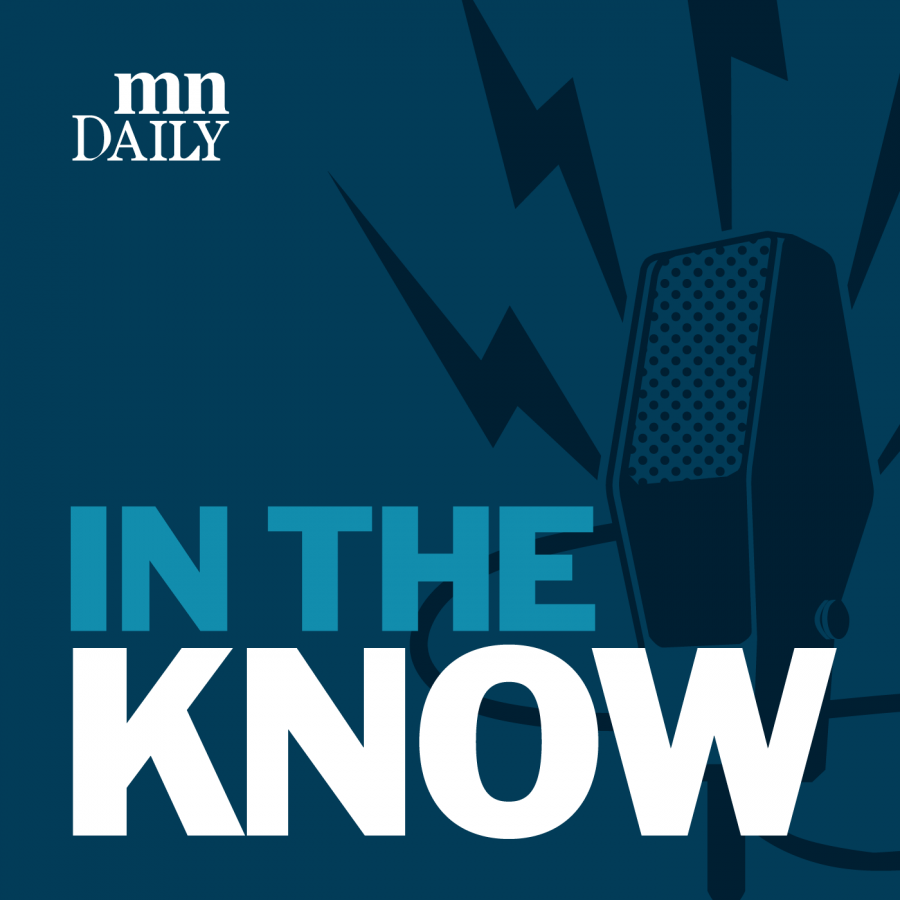MAYA ATHERLY-LARSEN: Hello, I’m Maya Atherly-Larsen.
ELISE TRAVIS: And I’m Elise Travis.
ATHERLY-LARSEN: Your hosts from the Minnesota Daily, and you’re tuning into In The Know, the podcast that brings you all the latest on the University of Minnesota. This past summer, we had an episode about artificial intelligence in education. Now? We’re going to explore AI in the art community.
TRAVIS: Artists today have been impacted by multiple AI programs and apps. For example, the programs Midjourney and DALL-E generate images from natural language descriptions called prompts. Adobe Firefly and Photoshop have generative machine learning models that modify, refine and remix images.
ATHERLY-LARSEN: With these new programs many schools around the country have begun accepting work based off of AI or in some cases, pieces generated by AI entirely. Eugene Park, the department chair of graphic design discusses how instructors have implemented it in design classes.
EUGENE PARK: Here in the graphic design program, instructors actually tried to welcome and encourage the use of these AI programs, but it’s under the caveat that they have to be done as a starting point. The thing about design is that design is much more than just the final outcome.
ATHERLY-LARSEN: Graphic design is an iterative process. There are discussions, conversations and critiques that go into it. All design choices are specific and intentional, which is not something that can be done with one AI prompt.
PARK: It’s like a whole like process from start to finish. We don’t just like come up with a visual from the first attempt and then call it a day. So I think that it could certainly be useful as a teaching tool particularly for students who kind of struggle with a very kind of a, almost like a starting point for various reasons.
TRAVIS: Photography professor Paul Shambroom says AI tools have made their way into the field of photography too.
PAUL SHAMBROOM: AI is certainly an extension of image making. The interesting thing to me is that a lot of the students were quite resistant to having this as part of their class. It wasn’t mentioned in the course description. AI was only one unit. It was, you know, one of five units that we did during the semester, but there is a feeling, well, there is a real variety of feelings, and there were strong emotional feelings that students had about this. And some were all for it and were very excited about the potential and the possibilities behind it. There were some who didn’t think it was photography and had nothing to do with photography and shouldn’t be incorporated in a photography class.
ATHERLY-LARSEN: While some are resistant to the possibilities of AI like Shambroom’s students, many artists have embraced AI tools within their own projects. Shambroom says that it’s been helpful in that it can create images based on what he thinks of.
SHAMBROOM: And they look almost like real photographs. I think the technology has been evolving so quickly that it’s currently totally realistic if you really know what you’re doing and I think that’s been the case for a while. I think the interest in AI, in image making, it seems like it’s come on quickly from nothing, but in fact, it’s been used in the industry of images for quite a while, and there have been aspects of it built into Photoshop, which is the main tool that’s used by photographers and also moving image makers.
TRAVIS: AI presents users with an array of challenges and issues, each taking on various forms. For instance, Adobe Firefly is promoted as a tool that empowers users to perform tasks such as text-to-image conversion, recoloring, 3D imaging and text effects. However, in practice, it falls short in certain aspects.
PARK: Firefly can certainly come up with just a general look and feel, but when it comes to, like, the nitty bitty details of that visual, it’s certainly kind of run into some challenges. So for example, as a quick test, I decided to like say, oh, I want so and so word to have like a specific like liquid viscosity to evoke some kind of emotion. And it was able to like just generate like the overall textures of it, but it has like some, all these extraneous, like details that were just not needed and something that I did not specify.
TRAVIS: AI has indeed revolutionized the way we approach writing and creative endeavors by significantly expediting the process. However, it’s essential to recognize that, according to Park, even in the case of advanced tools like Adobe Firefly, our human input remains indispensable.
PARK: It proceeded with me spending the next couple of minutes trying to like fine tune the prompt to get it exactly where I want, but it’s like the whole time I’m just like, you know what, this might’ve been a lot faster if I just took this to Photoshop and then just did everything myself rather than just wrestle like with the prompt. And, you know, certainly I can concede that a lot of this has to do with the newness, the novelty of the tool, where prompt engineering is certainly becoming like almost an expertise on its own.
ATHERLY-LARSEN: As the accessibility and utilization of these programs continue to expand, a myriad of concerns have arisen regarding the ethical implications.
SHAMBROOM: In terms of a discussion prompt that I gave the students and that is I asked their, to express their feelings on whether this is the end of the world for photography or if it’s the beginning in some ways. And also the question is, is this an evolutionary change, this technology, or is it a revolutionary change?
And they really went off on both those things. So the negatives certainly, the economic impact on some artists could be really bad. And I know that the stock photo agencies, that there’s already been some legal action, I can’t remember if it was Getty or one of the big stock photo places has some things going on in court because the way the technology works is it is scraping the internet.
ATHERLY-LARSEN: For some artists, a future with AI seems bleak. With programs being able to replicate entire art styles and create pieces at a much faster pace, many are concerned about their intellectual property and flow of income. But others feel that art and technology have actually been intertwined for years.
SHAMBROOM: To me, it’s another tool. It’s a radically different tool, but people have been naysaying technology and art for a long, long time. Not just in art, but in knowledge and communication. The printing press had its naysayers, optical devices that were used in painting, the camera obscura was used well before the invention of photography in the 19th century, and that was considered cheating. Digital photography and auto focus was considered cheating and auto exposure was considered cheating and it was, you know, there was a lot of doomsaying about the end of photography. So, this is just another voice in that chorus.
TRAVIS: Outside of copyright issues, software programs with subscriptions like Midjourney and DALL-E are bringing new perspectives. Despite much debate, Park feels AI is still a positive resource for designers.
PARK: These AI tools, in my opinion, does not present a new quote unquote threat for lack of a better word because, you know, on face value, what these AI tools are kind of offering is some kind of ready made like a visual that we can just kind of take and then use it for whatever purpose. Before we had like DALL-E and Midjourney or Stable Diffusion designers already had to deal with this problem.
Those are called templates, stock photos, ready-made designs that other people have made that they, other people, other designers can purchase or get a license to use. And what AI tools at currently as it stands is just that it just gives us one kind of additional thing for designers to choose from as opposed to replacing all of that. So based on that unless there’s something like truly revolutionary and unexpected that happens in this realm. I do not foresee AI tools completely disrupting the practice at all.
ATHERLY-LARSEN: With the growing use and accessibility of AI art, there has been much debate on the definition of what art actually is. While many think pieces by AI should be considered art based off of aesthetics and visual appeal, others think valid art is dependent on human thought and its physical process.
SHAMBROOM: AI is absolutely capable of creating art. Right now, it’s with, it’s in collaboration with humans. I know really some terrific artists and art that’s being generated that way. Will the computers take over and start making their own art? I hope so. They’ll try, but you know every algorithm starts with code that’s written by a human. So, every robot starts with, whether it’s a physical robot or a computer based robot. was made by humans, so I don’t think the human eye and the human voice can ever be removed from the artwork that comes out of it.
TRAVIS: It’s safe to say that AI isn’t going anywhere anytime soon, but how we use it now will determine our future with the technology.
PARK: It has certainly been kind of an interesting kind of experience just testing out these tools and try to push their limits to see what exactly they’re capable of. But in terms of the tools trying to replace some of the things that I do, no, it has certainly not been successful.
SHAMBROOM: It’s changing so quickly it’s mind boggling. It was all over the media, and I’m talking about the, you know, the sort of more mainstream, deeper, thoughtful media, which doesn’t necessarily correspond with mainstream, but the New York Times, the New Yorker, everybody was writing articles about what does this mean to us, and it’s just taken off since then. So it’s, as with any new technology whether it’s applied to art or any other aspect of our lives, it takes a while for us to catch up with the technology itself in terms of what it means, what its dangers, what its promises are. So it’s going to be an interesting ride.
ATHERLY-LARSEN: This episode was written by Maya Atherly-Larsen and Elise Travis and produced by Kaylie Sirovy. As always, we appreciate you listening and feel free to leave us an email at podcasting@mndaily.com with comments or questions. I’m Maya.
TRAVIS: I’m Elise, and this is In The Know.



